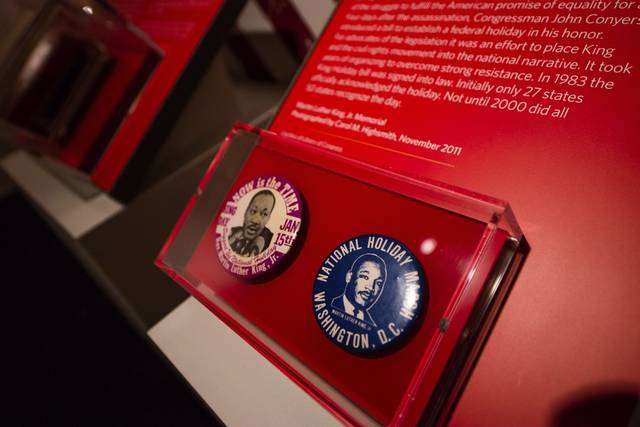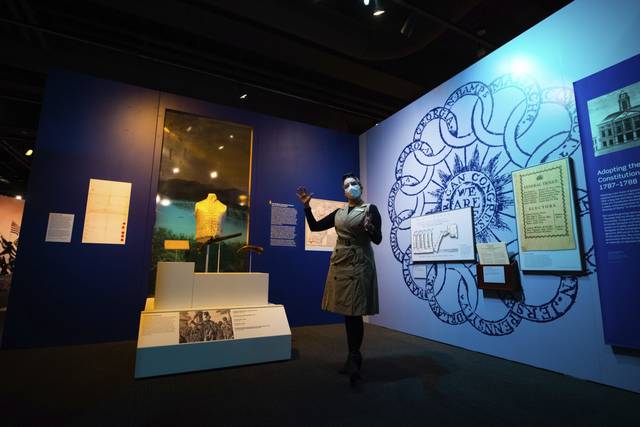Heinz History Center's new exhibition looks at 'American Democracy'
In one of its most ambitious projects to date, the Senator John Heinz History Center takes on the complex essence of the nation with its new exhibition, “American Democracy: A Great Leap of Faith,” opening Saturday.
It looks not just at the system of democracy and how the Founding Fathers crafted the core documents, but also provides a history of citizen participation – the expansion of voter rights, civil unrest and some of the movements that led to change in U.S. society.
“American Democracy” covers events from 1776, when the Declaration of Independence was issued, up through the past year — a span of 245 years.
By contrast, the History Center’s Vietnam War exhibition in 2019 covered only a 30-year period, from 1945-1975.
Enjoyed a preview of the Sen. John Heinz History Center's new exhibition "American Democracy: A Great Leap of Faith" this morning. It opens Saturday. My story to come on https://t.co/IYfLtEiX16. pic.twitter.com/2vbmBbojSm
— Paul Guggenheimer (@PGuggenheimer) March 11, 2021
“This particular exhibition comes at a very important time in American history. As you know, our country has suffered through a pandemic and political turmoil and questions of social and racial justice,” said Andy Masich, Heinz History Center president and CEO. “This exhibition helps us sort out American democracy and how we get along with one another.”
The exhibition, part of the History Center’s America 101 initiative, was developed in partnership with the Smithsonian‘s National Museum of American History.
It is localized to reveal how events in Pittsburgh and Western Pennsylvania history have helped shape our democracy, including the Whiskey Rebellion, African American and women’s suffrage, and the civil rights movement.
Highlights of the 7,000-square-foot exhibit include artifacts from the Founding Fathers, including a Pennsylvania land grant signed by Benjamin Franklin and a travel desk that belonged to George Washington (on loan from the Carnegie Museum).
There are also plenty of items representing the history of campaigning. In one of the featured display cases there are lots of presidential campaign ribbons, buttons and pins from 1840 to the present day.
“Not often do we have this kind of swath of time in a case. You can really see the transition in how people were using typography, using symbols, using color,” said Melissa E. Marinaro, the exhibition’s lead curator.
There are also clothing items — everything from a dress worn by Elsie Hillman to the Republican National Convention to a pair of red, white and blue bell-bottom pants from the 1970s.
Even more powerful objects representing the right to assemble and petition the government are on display, including a banner carried by University of Pittsburgh students during the legendary 1963 “March on Washington for Jobs and Freedom.”
There is also a Black Construction Coalition flag harkening back to the late 1960s when Black construction workers were barred from entering the unions. A local activist named Nate Smith, who had a union card, organized protests at construction sites that included Three Rivers Stadium, which opened in 1970.
But history doesn’t stop at any particular point in time in this exhibition, which also looks at the push for the Equal Right Amendment, the G-20 protests, the Pittsburgh Women’s March and the Black Lives Matter movement.
Marinaro was asked to curate this exhibition in 2018. She has worked hard to keep it up to date with the events that continue to shape American democracy.
“I’ve had to think about this exhibit in different ways since the pandemic started because we knew our audience was going to want to see us make connections between the present and the past,” said Marinaro. “So, there’s a lot in this exhibit that is cyclical. We can see that it’s not the first time as a nation that we’ve been confronted with making sure we’re strengthening our democracy.”
It’s also the first major exhibition for the Heinz Heinz History Center since the beginning of the pandemic.
“All of it was done under strict covid protocols and circumstances that made it difficult for the team — limiting the amount of staffers who could be in the exhibit area at one time and (delays) in items being delivered,” said Brady Smith, the History Center’s marketing and communications director. ”We’re really proud of our team for coming together and making this happen.”
The fact that the exhibition is happening just over two months since the Capitol insurrection is merely a coincidence, but the serendipitous timing is not lost on Marinaro.
“I felt hopeful creating this because I saw this as an opportunity to remind people that we can get through this, just as we’ve gotten through these other challenging moments,” she said. “We just need a little refresher because all of us have gone through a tumultuous year and sometimes it’s hard to see through the emotion of it when you’re in it.”
And there will be a quiz at the end of the exhibit. Visitors will have an opportunity to try their hand at a citizenship exam like the one given in the 20th century to people applying to become American citizens.
Remove the ads from your TribLIVE reading experience but still support the journalists who create the content with TribLIVE Ad-Free.



